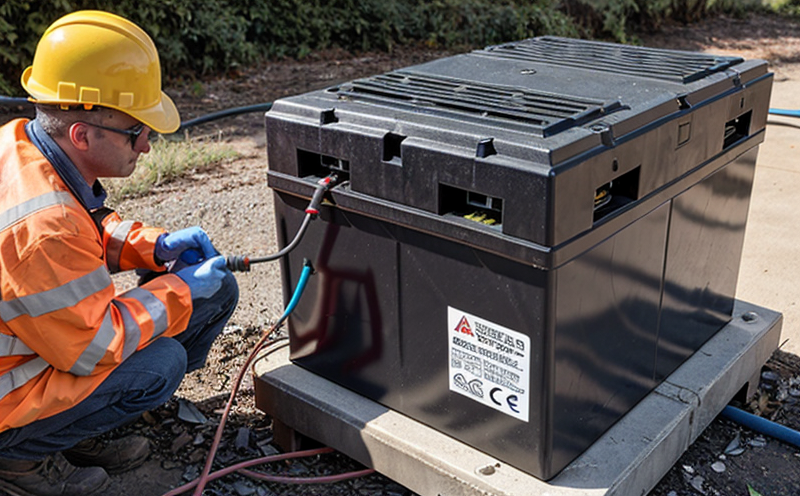IEC 61427 Lead-Acid Battery Testing for Renewable Energy Storage Systems
The International Electrotechnical Commission (IEC) standard IEC 61427 is a critical reference for the testing of lead-acid batteries used in renewable energy storage systems. This standard ensures that all batteries meet the highest quality and safety requirements, which is essential for ensuring reliable performance and extended lifespan in demanding applications.
IEC 61427 covers a broad range of tests designed to assess various aspects of lead-acid battery performance, including structural integrity, electrical conductivity, thermal stability, and more. These tests are particularly relevant for renewable energy storage systems due to the harsh environmental conditions they may face.
The testing protocol outlined in IEC 61427 is designed to evaluate batteries under real-world operating conditions, ensuring that they can withstand the stresses of frequent charge-discharge cycles and extreme temperature variations. This standard plays a crucial role in verifying that lead-acid batteries are capable of providing reliable power storage solutions for renewable energy installations.
Compliance with IEC 61427 is not only important for regulatory reasons but also helps manufacturers build trust with their customers by demonstrating adherence to internationally recognized quality and safety standards. This is especially true in the context of renewable energy systems, where reliability and performance are paramount.
The standard includes detailed instructions on how to conduct various tests, including discharge capacity tests, cold cranking current tests, and high-temperature endurance tests. These tests help ensure that lead-acid batteries can deliver consistent power output even under adverse conditions, which is critical for the success of renewable energy storage systems.
| Test | Description |
|---|---|
| Discharge Capacity Test | Determines the amount of energy a battery can deliver over time. |
| Cold Cranking Current Test | Evaluates the starting ability of the battery under cold conditions. |
| High-Temperature Endurance Test | Assesses the battery's performance at elevated temperatures. |
Benefits of IEC 61427 Lead-Acid Battery Testing for Renewable Energy Storage Systems
- Enhanced Reliability: Ensures that batteries meet stringent quality and safety standards.
- Extended Lifespan: Tests help identify potential weaknesses that can lead to premature battery failure.
- Regulatory Compliance: Helps manufacturers comply with international regulations for renewable energy storage systems.
- Customer Trust: Demonstrates commitment to high-quality products and services, building customer confidence.
Industry Applications of IEC 61427 Lead-Acid Battery Testing
The IEC 61427 standard finds extensive application in the renewable energy sector, particularly for lead-acid batteries used in solar power systems and wind turbines. These batteries play a critical role in storing excess energy generated during peak production times, which can then be utilized when demand exceeds supply.
IEC 61427 testing is essential for ensuring that these batteries can withstand the harsh environmental conditions often found in renewable energy installations. For instance, solar power systems may operate in high-temperature environments, while wind turbines are exposed to extreme cold and wind loads. The tests outlined in IEC 61427 help ensure that lead-acid batteries can perform reliably under such challenging conditions.
| Application | Battery Requirements |
|---|---|
| Solar Power Systems | Batteries must have high discharge capacity and good cold cranking current. |
| Wind Turbines | Batteries need to withstand high-temperature endurance tests effectively. |
International Acceptance and Recognition of IEC 61427
The IEC 61427 standard is widely recognized and accepted by regulatory bodies, manufacturers, and consumers worldwide. Its adoption ensures consistent quality across different geographic locations, making it easier for businesses to operate globally.
Many countries have incorporated the requirements of IEC 61427 into their national standards, further emphasizing its importance in the renewable energy sector. Compliance with this standard not only facilitates international trade but also helps manufacturers meet the expectations of discerning customers who demand high-quality products.
The widespread acceptance of IEC 61427 also contributes to the development of a more standardized and interoperable market for lead-acid batteries used in renewable energy storage systems. This standardization is crucial for fostering innovation and ensuring that new technologies can be seamlessly integrated into existing systems.
By adhering to the IEC 61427 standard, manufacturers demonstrate their commitment to producing reliable and safe products, which ultimately enhances the performance and longevity of renewable energy storage systems. This, in turn, supports the broader goal of promoting sustainable energy solutions globally.





